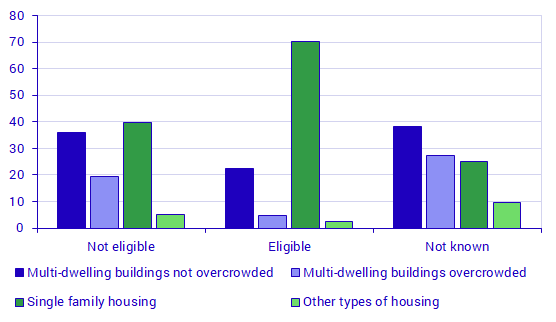Upper secondary pupils’ housing situation
Overcrowding more common among pupils not eligible for upper secondary school
Statistical news from Statistics Sweden 2021-01-14 9.30
Overcrowding is more common among upper secondary school pupils who were not eligible for upper secondary school, who have a foreign background, or whose parents had at most lower secondary education.
During the coronavirus (COVID-19) pandemic, upper secondary schools have, at times, conducted distance teaching. Surveys from agencies such as the Swedish Schools Inspectorate and the Swedish National Agency for Education show that some pupils have experienced difficulties with distance studies because of the home environment and the study environment.
A compilation of upper secondary pupils' housing conditions shows that eight percent of all upper secondary pupils lived in overcrowded households (norm 2). It is only possible to retrieve data on overcrowded living conditions for those living in multi-dwelling buildings and in special housing.
Among the 350 000 upper secondary pupils registered in the population on 15 October 2019, 63 percent lived in single family housing, which was the most common form of housing. This was followed by multi-dwelling buildings or special housing, in which around 34 percent of upper secondary pupils lived. Among these pupils, 25 percent had overcrowded living conditions.

Among all upper secondary pupils who were not eligible for upper secondary school, around 30 percent had overcrowded living conditions, and among those with unknown eligibility, 27 percent had overcrowded living conditions. This can be compared with upper secondary pupils who were eligible for upper secondary school, among whom only five percent had overcrowded living conditions.
Overcrowded living conditions were also more common among upper secondary pupils with a foreign background, and among those with parents with at most lower secondary education.
Living space per person
It is possible to calculate the living space per inhabitant for all upper secondary pupils, including those living in single family housing. The same trend can also be seen among those living in single family housing; households with a small living space per inhabitant were more common among pupils who were not eligible for upper secondary school, had a foreign background, or whose parents had at most lower secondary education.
Among all upper secondary pupils, there is a larger proportion who have a smaller living space per inhabitant, than among upper secondary pupils living in single family housing. Among those living in single family housing, 10 percent have less than 20 square metres per person, which corresponds to 20 percent of all upper secondary pupils.
According to the latest PISA survey in 2018, which includes a question about having their own room, the proportion of 15-year olds who had their own room was lowest among foreign born pupils, and among pupils whose parents had at most lower secondary education.
Statistical Database
More information is available in the Statistical Database
Feel free to use the facts from this statistical news but remember to state Source: Statistics Sweden.
